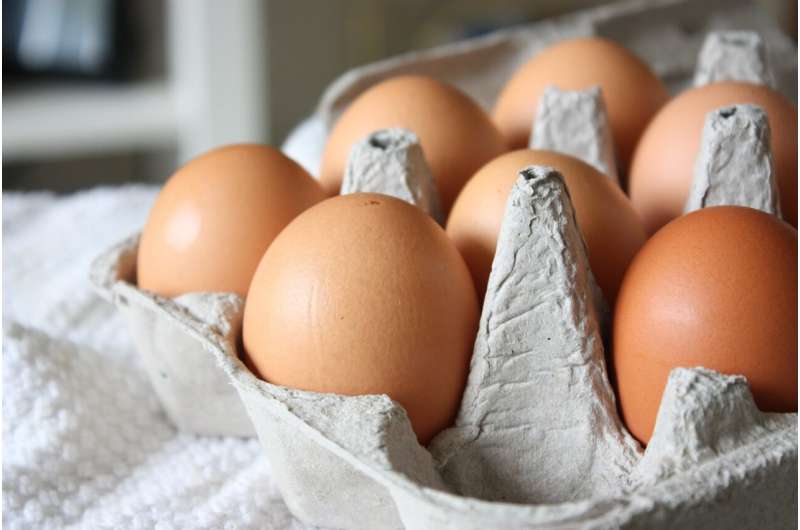Egg prices soar as outdated supply chains crack under pressure

There may be no kitchen table issue in America more critical than the price of food.
So when the , it became a headline news story in Colorado and across the nation.
and blamed high egg prices on bird flu outbreaks and said containing the outbreak in supply chains would lower prices. In early March 2025, egg prices fell in the U.S., but these trends are likely to reverse .
Rising prices and market volatility have led to food costs climbing to 11.4% of American's disposable income, .
Arresting these rising costs, as I argue in , means to address the growing supply, demand and price volatility that has created uncertainty for consumers since the COVID-19 pandemic of 2020.
I have described global supply chains, and supply chains in the U.S. in particular, as "." By this I mean that they aspire to offer low prices from economies of scale but lack sufficient resiliency to create stability.
Without addressing the systemic weaknesses in supply chains, I believe major health and economic disruptions will continue to happen in Colorado, nationally and around the world.
Cage-free eggs
Colorado faces a double whammy where egg prices are concerned.
It's one of nine states with a , which requires all eggs sold in the state to come from cage-free facilities. The regulation has been shown to increase the .
Over the past two decades, cage-free egg laws have been passed in states as consumers have of farm animals. What that means varies from state to state because the term cage-free isn't regulated by a federal agency. In Colorado, egg-laying hens must be housed in a cage-free system and must have of usable floor space per hen.
, far behind Midwestern states such as Iowa, Indiana and Ohio, but it has a few large producers such as , as well as smaller ones such as the , a collection of seven family-owned farms.
Colorado's in January 2025—around the same time that at their supermarkets. Many consumers and some blamed the cage-free law.
to deal with the challenge of unaffordable egg prices.
But cage-free laws are not the main driver of increasing egg prices, . Like many others, the egg supply chain needs to be reinvented to balance price, scale, resiliency and stability.
Supply chain issues
What is driving up the prices of eggs and other consumer goods is the concentration of producers. The COVID-19 pandemic revealed just how vulnerable prices and supply chains are.
Five years ago this month, when the pandemic started, .
In 2022, a major product recall of Similac led to . The baby formula market is highly concentrated, with four companies responsible for approximately 90% of the domestic market. A large-scale facility that produced the baby formula was found to have . Pulling this one facility offline at the same time the nation was coping with pandemic-related supply chain issues led to the shortage.
Then at the beginning of 2024, due to production issues at Eli Lilly, one of the three companies responsible for over 90% of the U.S. insulin market.
And in the second half of 2024, due to damage caused by Hurricane Helene to a Baxter factory in North Carolina that manufactures approximately 60% of IV fluids in the U.S. This factory had been relocated to North Carolina from Puerto Rico that damaged the island in 2017.
In all of these cases, the supply chain was easily interrupted due to a reliance on a few large producers. In 2025, bird flu and eggs are just another example of America's "efficiently broken" supply chain.
Bird flu and cost of eggs
In the U.S., the top , with Mississippi-based Cal-Maine Foods alone responsible for 13% of total U.S. production.
An average-sized production facility in the U.S. . Large facilities can house . The mass production of eggs from these facilities means eggs are, in stable times, cost effective for the American consumer. , and it was an affordable food solution compared with processed foods.
But this scale and efficiency comes at the price of resiliency during something like a bird flu outbreak. Larger farms create a higher risk of viral outbreak, which leads to the and a heightened risk of viral replication and mutation.
The solution may increase prices
Policymakers want to at American egg factories to mitigate the spread of bird flu. But these measures are expensive.
Factory farms increase the . Therefore, bird flu is a more serious precursor of supply chain disruption than a hurricane or product recall because it has the potential to create a public health crisis.
One solution to limit the spread of bird flu is to . This would lead to smaller and more farms across the U.S., but also higher consumer prices.
This solution would mirror other countries such as Canada, where the average facility size is much smaller than in the U.S. and . That's why—under the terms of the United States-Mexico-Canada Agreement—Canada has quota and tariff protection from American companies flooding its market with .
Yet in March 2025, than eggs in the U.S. because the country has not suffered the same damages from bird flu.
Following Canada's lead wouldn't result in egg prices as low as giant factory farms, but it would protect American consumers from the periodic price shocks caused by disease or localized weather events that disrupt supplies.
Despite the threat of a public health crisis, American consumers don't want to pay more for eggs—and they won't have to.
Provided by The Conversation
This article is republished from under a Creative Commons license. Read the .![]()


















